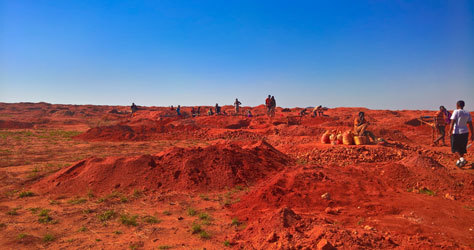- Destinations. 10 incredible places in Africa that you have to step on sometime
- Adventure. 10 safaris to do once in a lifetime (and not just in Africa)
A crater of clayey earth, parched by the sun, descends steeply towards the puddled water, of an indefinite color. The landscape has nothing to do with the green rolling hills of northern and central Madagascar. Nor with the clichés of baobabs and lemurs, because this is a panorama formed by the action of man. If you look closely, you can also distinguish different terraces that vaguely recall the sloping crops of the Peruvian mountains, only here the harvest is sapphires.
A rough 120-kilometer-sided rectangle delimits the Ilakaka mining area, the Wild West south of Madagascar, a place that barely featured on maps until late 1998, when a seam was discovered by chance in a rice field , where work was being done to get more water. The news spread like wildfire and soon came a tide of Malagasy willing to seek their fortune underground, although reality indicates that most of the sale is now controlled by merchants from Thailand and Sri Lanka.
Work method
Ilakaka is reached by National Highway 7, which looks more than discreet, although it is the main route to reach the famous beaches of Tuléar . The population has grown clearly attached to the route and along it a series of flimsy structures are deployed where they sell from shovels to mobiles, passing through the essential sieves to wash the earth in search of sapphires: here there is no place for souvenirs .
In the shade, buyers armed with small lanterns await, which they use to check the excellence of the stones . It is the first link in a long chain of intermediaries that leads to the final retailer, who sells the finished product. It must be taken into account that a good part of the gems are of low quality, so it is necessary to heat them first and clean them with the help of chemicals and carve them later. High-end gems are considered almost an extra for the work of the miner , so that he lives on the volume that he extracts and not so much on the price of each stone.
The gemologist Guillaume Souviraa arrived here a year after the discovery of sapphires, to the finishing high school. Successive trips encouraged him to settle in Ilakaka in 2005 and today he is part of Colorline, the only tour operator in the city: "Our utility lies in offering a door between two worlds and, above all, helping to promote Malagasy stones , since the more recognized they are, the more they will be sold and the more benefits the workers will obtain. "
A lunar landscape
The extraction conditions are almost more amazing than the lunar landscape that opens before the visitor. Seen up close, the ground reveals as many holes as a sieve around the gigantic crater. The reason is easy to understand, Guillaume says: "All the mining work in Ilakaka is carried out manually, by solitary workers or small family groups. Each one has its own particular exploitation, since extraction is very complex. Large companies They do not invest in this type of work, it is not worth investing in heavy machinery. "
You are absolutely right: 80% of the world's gems come from small-scale mining. Madagascar was not going to be the exception. As in a biblical scene, dozens of miners move around the place; some form rows and collaborate to transport the mineral accompanied by songs. The atmosphere that is breathed is harsh, but it also has the dignity of the everyday epic . Here and there, men slide through holes wide enough to pass without contorting, but narrow enough to cause claustrophobia just by looking at them.
They reach an average depth of 20 meters, although some reach 50 meters. The reef awaits below. In eight-hour shifts a man fills the bags of earth. Outside, one or two more hoist them up with a pulley and ropes. Hopefully, a third party will extract the gas and stale air from the interior, using such rudimentary technology as a tube and a plastic bag that acts as a bellows. The sacks are then hauled into a pond where the ore is washed to separate the dirt from the raw sapphires. When finished, the miners take a dip in the same stagnant water .
The image barely conveys the measure of the effort that these people make, but in a country where many people live on less than two euros a day, the dream of wealth is a powerful magnet. Once the tour of the mines is over, it is even more fascinating to contemplate in the shops the brightness of the pink and blue sapphires ... It would seem that when they came to the surface they wanted to catch the sunlight that illuminates such an untouristic enclave, but so evocative, like Ilakaka.
According to the criteria of The Trust Project
Know more- tourism
- Africa
Art Cultural tourism in Spain, the pending subject of a country with one of the best heritages in the world
Ranking It's not snow, it's sand: why this beach has been voted the best in the United States
The PhilippinesThe secrets of Vigán, the colonial city in Asia that most reminds of Spain
See links of interest
- News
- Translator
- Programming
- Calendar
- Horoscope
- Classification
- Films
- Cut notes
- Topics
- Leipzig - Atlético de Madrid, live

